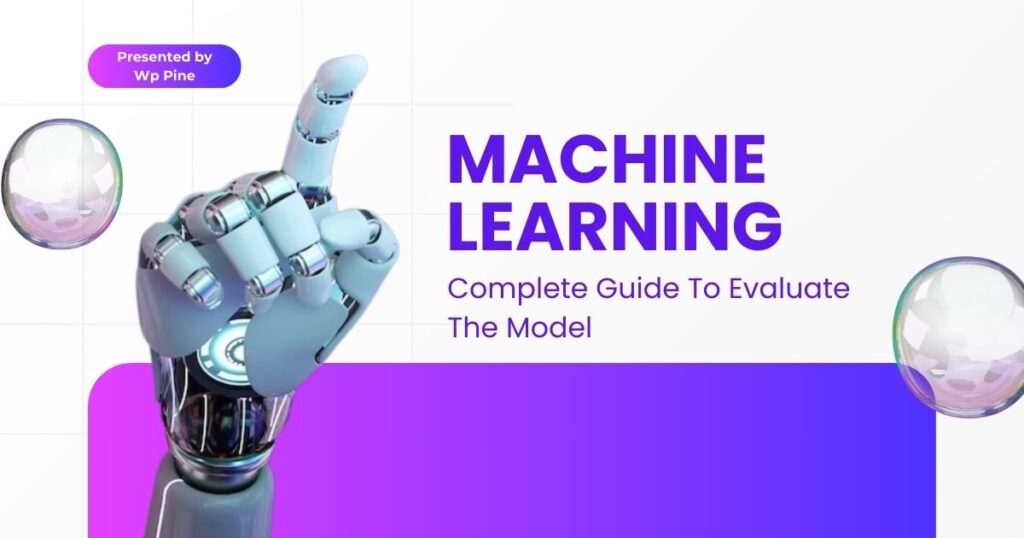As machine learning as a subfield strengthens and takes its place as a more and more obligatory component in data analysis procedures, the evaluation of machine learning models is a vital task. Cross-validation is a procedure of revealing how adequately the given model can function on data that have not been used before and is one of the main factors when assessing the models’ value, efficiency, stability, and suitability for definite tasks. This tutorial in machine learning is going to include a general description of the importance of model evaluation, the types of metrics used in this process, the methods of evaluating models, the trends existing in model evaluation, and the real cases of model evaluations.
Importance of Model Evaluation
Model evaluation serves several crucial purposes in machine learning:
- Performance Assessment: It tells how well a model can predict outcomes against actual data.
- Generalization: This is how the model generalized beyond the learning into new, unseen data.
- Comparison: Allows for comparison between models as a way of selecting the best-fit model to be deployed.
- Decision-Making: Provides insight into model improvement and makes decisions based on the results of that improvement.
Key Metrics for Model Evaluation
Experimental objectives or evaluation metrics should be selected about the type of machine learning task, such as classification, regression, or clustering, and directly considering the aims in view for the analysis. Let us discuss essential metrics of machine learning which are categorized by task type:

Classification Metrics
In machine learning classification tasks, predict models categorical labels or classes.
- Accuracy:
- Definition: The proportion of correct predictions out of the total predictions made by the model.
- Formula: {Accuracy} = frac{text{Number of Correct Predictions}}{text{Total Number of Predictions}}
- Precision and Recall:
- Precision: Measures the accuracy of positive predictions.
- {Precision} = frac{text{True Positives}}{text{True Positives} + text{False Positives}}
- Recall (Sensitivity): Measures how well the model captures positive instances.
- {Recall} = frac{text{True Positives}}{text{True Positives} + text{False Negatives}}
- Precision: Measures the accuracy of positive predictions.
- F1 Score:
- Definition: Harmonic mean of precision and recall, providing a balanced measure.
- Formula: F1 = 2 cdot frac{text{Precision} cdot text{Recall}}{text{Precision} + text{Recall}}
- Confusion Matrix:
- Definition: Table that summarizes the number of correct and incorrect predictions made by a classification model.
- Components: True Positives (TP), False Positives (FP), True Negatives (TN), False Negatives (FN).
Regression Metrics
In machine learning regression task, it involves predicting continuous numeric values.
- Mean Absolute Error (MAE):
- Definition: Average of the absolute differences between predicted and actual values.
- Formula: {MAE} = frac{1}{n} sum_{i=1}^{n} left| text{predicted}_i – text{actual}_i right|
- Mean Squared Error (MSE):
- Definition: Average of the squared differences between predicted and actual values.
- Formula: {MSE} = frac{1}{n} sum_{i=1}^{n} left( text{predicted}_i – text{actual}_i right)^2
- Root Mean Squared Error (RMSE):
- Definition: Square root of MSE, providing a measure of the average magnitude of error.
- Formula: {RMSE} = sqrt{text{MSE}}
- R-squared (Coefficient of Determination):
- Definition: Proportion of the variance in the dependent variable that is predictable from the independent variables.
- Formula: R^2 = 1 – frac{text{SSE}}{text{SST}}
- where SSE is the sum of squared errors and SST is the total sum of squares.
Model Evaluation Techniques
Beyond selecting metrics, employing effective evaluation techniques enhances the reliability and robustness of model assessment:
- Cross-Validation:
- Divides data into multiple subsets (folds) for training and testing, ensuring models generalize well to new data.
- Types: k-fold cross-validation, stratified cross-validation.
- Learning Curves:
- Plots showing how model performance changes with increasing training data size, helping diagnose bias or variance issues.
- Interpretation: High training error suggests underfitting, while a large gap between training and validation error indicates overfitting.
- ROC Curve and AUC:
- ROC (Receiver Operating Characteristic) Curve: A plot of the true positive rate against the false positive rate, at different thresholds for a predictive model.
- AUC (Area Under the Curve): The Area Under the Curve is a metric approximating the integral of the ROC curve and, hence, is a measure of the quality of the whole model.
- Hyperparameter Tuning:
- This implies enhanced performance of a model through the tuning of hyperparameters—learning rate or regularization—either through grid search or random search.
Model Comparison and Selection
Evaluating and selecting the best machine learning model for a given task involves several steps and techniques. This process ensures that the chosen model of machine learning not only performs well on training data but also generalizes effectively to new, unseen data. Here’s a detailed breakdown of the key components involved in model comparison and selection:

1. Baseline Models
- Definition: Baseline models serve as a reference point for comparing the performance of more complex models. They are simple models that are easy to implement and interpret.
- Examples:
- Mean Predictor: For regression tasks, predicts the mean of the target variable.
- Random Classifier: For classification tasks, labels are randomly based on the distribution of the classes.
- Purpose: Ensuring that the performance improvements from more sophisticated models are meaningful and not due to overfitting or data quirks.
2. Hyperparameter Tuning
- Definition: The process of optimizing the hyperparameters of a model to improve its performance. Hyperparameters are parameters whose values are set before the learning process begins, unlike model parameters which are learned from the data.
- Techniques:
- Grid Search: Exhaustively searches through a specified subset of hyperparameters. It evaluates all possible combinations to find the best set.
- Random Search: Randomly samples hyperparameters from a specified distribution. It is often more efficient than grid search because it does not explore every combination.
- Bayesian Optimization: Uses a probabilistic model to select the most promising hyperparameters, balancing exploration and exploitation.
- Example Hyperparameters: Learning rate, regularization strength, number of layers in a neural network, kernel parameters for SVMs.
3. Ensemble Methods
- Definition: Techniques that combine the predictions of multiple models to produce a single, superior prediction. Ensembles generally improve model performance by reducing variance and bias.
- Types:
- Bagging (Bootstrap Aggregating):
- Process: Creates multiple subsets of the training data by sampling with replacement and trains a separate model on each subset.
- Example: Random Forest, which averages the predictions of multiple decision trees.
- Boosting:
- Process: Trains models sequentially, where each model attempts to correct the errors of the previous ones. The final prediction is a weighted sum of the individual models.
- Example: Gradient Boosting Machines (GBM), AdaBoost, XGBoost.
- Stacking:
- Process: Trains multiple base models and a meta-model that learns to combine their predictions. The base models’ predictions are used as input features for the meta-model.
- Example: Combining logistic regression, decision trees, and SVMs, with a neural network as the meta-model.
- Advantages: Enhances predictive performance, reduces the risk of overfitting, and can capture a wider range of patterns in the data.
4. Model Selection Criteria
- Performance Metrics: Using appropriate metrics based on the problem type (e.g., accuracy, precision, recall, F1 score for classification; MAE, MSE, R-squared for regression).
- Complexity: Balancing model complexity with performance. More complex models may overfit the training data but fail to generalize well to new data.
- Interpretability: Choosing a model that stakeholders can understand and trust, especially in applications where explainability is crucial.
- Scalability: Ensuring the model can handle large datasets and be deployed efficiently in production environments.
- Robustness: Assessing how well the model performs under various conditions, including noisy or missing data.
- Fairness: Evaluating the model for biases and ensuring it provides fair treatment across different groups.
5. Cross-Validation
- Purpose: To estimate the model’s performance on unseen data by partitioning the data into training and validation sets multiple times.
- Techniques:
- K-Fold Cross-Validation: Splits the data into K subsets (folds) and trains the model K times, each time using a different fold as the validation set and the remaining folds as the training set.
- Stratified K-Fold Cross-Validation: Ensures each fold has the same proportion of class labels, which is particularly important for imbalanced datasets.
- Leave-One-Out Cross-Validation (LOOCV): A special case of K-fold where K equals the number of data points. It provides an exhaustive evaluation but is computationally expensive.
6. Statistical Tests for Model Comparison
- Paired t-test: Used to compare the performance of two models on the same dataset to determine if there is a statistically significant difference.
- Wilcoxon Signed-Rank Test: A non-parametric alternative to the paired t-test, useful when the performance differences do not follow a normal distribution.
7. Visualization Techniques
- Learning Curves: Plots that show how model performance changes with increasing training data size, helping diagnose bias (underfitting) or variance (overfitting) issues.
- ROC Curve and AUC: The ROC curve plots the true positive rate against the false positive rate at different thresholds, while the AUC represents the area under this curve, providing a single metric to evaluate the model’s performance.
Overfitting and Underfitting
Overfitting and underfitting are common issues in machine learning that affect a model’s ability to generalize to new data. Understanding these concepts and how to address them is crucial for building effective and reliable models of machine learning. Here’s a detailed breakdown:
- Overfitting: Occurs when a model learns the noise and details in the training data to such an extent that it negatively impacts the model’s performance on new data. Overfitting results in a model that is too complex.
- Underfitting: Occurs when a model is too simple to capture the underlying patterns in the data, leading to poor performance both on the training data and new data. Underfitting results in a model that is not complex enough.
Symptoms
Overfitting:
- High Training Accuracy, Low Validation Accuracy: The model performs exceptionally well on the training data but poorly on the validation or test data.
- High Variance: The model’s performance varies significantly between different datasets.
- Complex Models: Using models with too many parameters (e.g., deep neural networks with many layers) can lead to overfitting.
Underfitting:
- Low Training and Validation Accuracy: The model performs poorly on both the training and validation data.
- High Bias: The model fails to capture the underlying trend of the data.
- Simple Models: Using overly simple models (e.g., linear regression for nonlinear data) can lead to underfitting.
Causes
Overfitting:
- Complex Model Architecture: Using models that are too complex for the amount of training data.
- Noise in Data: Learning from the noise or random fluctuations in the training data.
- Insufficient Data: Not having enough training data for the model’s complexity.
- Too Many Features: Including irrelevant features that add noise to the model.
Underfitting:
- Simple Model Architecture: Using models that are too simple to capture the complexity of the data.
- Insufficient Training: Not training the model for enough epochs or iterations.
- High Regularization: Applying too much regularization that forces the model to be too simplistic.
- Poor Feature Selection: Using features that do not capture the underlying patterns in the data.
Detection
- Learning Curves: Plotting learning curves can help detect overfitting and underfitting. A large gap between training and validation error typically indicates overfitting, while both errors being high suggests underfitting.
- Cross-Validation: Using cross-validation techniques to assess model performance on different subsets of data can reveal overfitting or underfitting.
- Performance Metrics: Monitoring metrics such as accuracy, precision, recall, and F1 score on both training and validation sets.
Solutions
Overfitting:
- Simplifying the Model: Reducing the complexity of the model by decreasing the number of features or parameters.
- Regularization: Applying techniques such as L1 (Lasso) or L2 (Ridge) regularization to penalize large coefficients and reduce model complexity.
- Pruning (for Decision Trees): Removing parts of the model that are not important or that contribute to overfitting.
- Dropout (for Neural Networks): Randomly dropping units (along with their connections) during training to prevent overfitting.
- More Training Data: Increasing the size of the training dataset can help the model generalize better.
- Cross-Validation: Using cross-validation to tune hyperparameters and select the best model.
Underfitting:
- Increasing Model Complexity: Using more complex models that can capture the underlying patterns in the data (e.g., adding more layers to a neural network).
- Reducing Regularization: Decreasing the regularization parameter to allow the model more flexibility.
- Feature Engineering: Creating more relevant features or transforming existing features to better capture the underlying data patterns.
- Increasing Training Duration: Training the model for more epochs or iterations to allow it to learn better from the data.
- Hyperparameter Tuning: Experimenting with different hyperparameters to find a better fit for the model.
Balancing Model Complexity
- Bias-Variance Tradeoff: Understanding the tradeoff between bias (error due to underfitting) and variance (error due to overfitting) is essential for finding the right model complexity.
- Validation Set Performance: Continuously monitoring the model’s performance on a validation set to ensure it neither overfits nor underfits.
- Model Ensemble: Using ensemble methods like bagging and boosting can help balance between overfitting and underfitting by combining multiple models.
Interpreting Model Results
Interpreting the results of machine learning models is a crucial step in the machine learning process. It ensures that the insights derived from the model are accurate, reliable, and actionable for the model of machine learning. Here’s a detailed breakdown of the key aspects involved in interpreting model results:
Understanding Performance Metrics
- Accuracy: The ratio of correctly predicted instances to the total instances. It is useful for balanced datasets but can be misleading for imbalanced datasets.
- Formula: {Accuracy} = frac{text{Number of Correct Predictions}}{text{Total Number of Predictions}}
- Precision, Recall, and F1 Score:
- Precision: The ratio of correctly predicted positive instances to the total predicted positives. It indicates how many of the predicted positives are actual positives.
- Formula: {Precision} = frac{text{True Positives}}{text{True Positives} + text{False Positives}}
- Recall (Sensitivity): The ratio of correctly predicted positive instances to the total actual positives. It indicates how many actual positives were correctly identified.
- Formula: {Recall} = frac{text{True Positives}}{text{True Positives} + text{False Negatives}}
- F1 Score: The harmonic mean of precision and recall, providing a balance between the two metrics.
- Formula: F1 = 2 cdot frac{text{Precision} cdot text{Recall}}{text{Precision} + text{Recall}}
- Precision: The ratio of correctly predicted positive instances to the total predicted positives. It indicates how many of the predicted positives are actual positives.
- Confusion Matrix: A table used to evaluate the performance of a classification model, showing the true positives, true negatives, false positives, and false negatives.
- ROC and AUC:
- ROC Curve: Plots the true positive rate (TPR) against the false positive rate (FPR) at various threshold settings.
- AUC (Area Under the Curve): Measures the entire two-dimensional area underneath the ROC curve, providing an aggregate measure of performance across all thresholds.
Evaluating Model Fairness and Bias
- Bias and Fairness Analysis: Assessing the model for any inherent biases that could lead to unfair treatment of certain groups. This involves analyzing performance metrics across different demographic groups to ensure fairness.
- Fairness Metrics:
- Demographic Parity: Ensuring that the model’s predictions are equally distributed across different demographic groups.
- Equalized Odds: Ensuring that the model’s true positive rate and false positive rate are similar across different groups.
- Equal Opportunity: Ensuring that the true positive rate is the same for all groups.
Model Interpretability Techniques
- Feature Importance: Identifying which features contribute the most to the model’s predictions. This can be done using techniques like:
- Gini Importance or Mean Decrease in Impurity (MDI): Used in decision trees and random forests.
- Permutation Feature Importance: Measures the decrease in model performance when a feature’s values are randomly shuffled.
- SHAP (SHapley Additive exPlanations): A unified approach to explain the output of any machine learning model.
- Partial Dependence Plots (PDPs): Show the relationship between a selected feature and the predicted outcome, marginalizing the values of all other features.
- LIME (Local Interpretable Model-agnostic Explanations): Explains individual predictions by approximating the model locally with a simpler, interpretable model.
Analyzing Residuals
- Residual Analysis: For regression models, analyzing residuals (the differences between observed and predicted values) helps diagnose model performance issues.
- Patterns in Residuals:
- Random Distribution: Indicates a good fit.
- Patterns or Trends: Suggest issues like heteroscedasticity or model misspecification.
- Residual Plots: Visualizing residuals against predicted values or input features to detect non-linearity, outliers, and other issues.
Validation and Testing
- Cross-Validation Results: Analyzing performance metrics from cross-validation to ensure the model generalizes well to unseen data.
- Test Set Performance: Evaluate the model on a separate test set to get an unbiased estimate of its performance.
Comparing with Baseline Models
- Baseline Comparison: Comparing the model’s performance with baseline models to ensure that the chosen model offers a significant improvement. Baseline models could be simple algorithms like mean prediction for regression or random classifiers for classification.
Uncertainty and Confidence Intervals
- Confidence Intervals: Estimating the range within which the true model performance metric lies with a certain probability. This provides a sense of the uncertainty in model predictions.
- Prediction Intervals: Providing a range within which future observations are expected to fall, offering insights into the reliability of individual predictions.
Communicating Results
- Clear Reporting: Presenting model results clearly and understandably to stakeholders, using visualizations and summary statistics.
- Actionable Insights: Translating model findings into actionable insights that can drive decision-making. This involves highlighting key patterns, trends, and predictions that are relevant to the business or research objectives.
- Limitations and Assumptions: Discuss the limitations of the model and the assumptions made during model development and evaluation to provide a comprehensive understanding of the results.
Real-World Considerations in Machine Learning
When deploying machine learning models in real-world applications, several practical aspects must be considered to ensure their effectiveness, robustness, and sustainability. Here’s a detailed breakdown of these considerations:
Data Quality and Availability
- Data Collection: Ensuring the availability of sufficient and relevant data for training, validation, and testing. The data must be representative of the real-world scenarios where the model will be applied.
- Data Cleaning: Addressing issues such as missing values, outliers, and inconsistencies. Clean and preprocessed data lead to more accurate and reliable models.
- Data Labeling: For supervised learning, ensuring that the data is accurately labeled. Inaccurate labels can lead to poor model performance.
- Data Privacy and Security: Ensuring compliance with data privacy laws and regulations (e.g., GDPR) and protecting sensitive information from unauthorized access and breaches.
Model Deployment and Scalability
- Deployment Environment: Choosing the right environment for deploying the machine learning model, whether on-premises, in the cloud, or at the edge. This involves considerations of computational resources, latency, and integration with existing systems.
- Model Serving: Implementing efficient model serving techniques to handle real-time predictions and batch processing. Tools like TensorFlow Serving, ONNX Runtime, or custom REST APIs can be used.
- Scalability: Ensuring the model can scale to handle large volumes of data and a high number of requests. This might involve using distributed computing frameworks and load-balancing techniques.
Model Maintenance and Monitoring
- Model Drift: Continuously monitoring model performance to detect and address model drift, where the model’s performance degrades over time due to changes in the underlying data distribution.
- Retraining and Updating: Implementing a strategy for retraining the model periodically or when significant performance drops are detected. This can involve automated retraining pipelines.
- Versioning: Keeping track of different model versions to ensure reproducibility and the ability to roll back to previous versions if needed. Tools like MLflow or DVC (Data Version Control) can be helpful.
Interpretability and Transparency
- Explainable AI: Ensuring that the machine learning model’s decisions can be understood and interpreted by humans. This is crucial for gaining trust from stakeholders and for regulatory compliance in certain industries.
- Transparency: Provide clear documentation on how the model was developed, the data used, and the assumptions made. Transparency helps in auditing and debugging the model.
Ethical and Fairness Considerations
- Bias and Fairness: Assessing the model for potential biases that could lead to unfair treatment of certain groups. Implementing techniques to mitigate bias and ensure fairness in predictions.
- Ethical Implications: Considering the broader ethical implications of deploying the model, such as the impact on employment, privacy concerns, and potential misuse.
Integration with Business Processes
- Stakeholder Involvement: Engaging with stakeholders throughout the model development and deployment process to ensure the model meets business requirements and adds value.
- Process Automation: Integrating the model into business processes to automate decision-making and improve efficiency. This involves ensuring seamless integration with existing software systems and workflows.
- User Training: Providing training and support to end-users to ensure they can effectively use and interpret the model’s outputs.
Performance and Reliability
- Robustness: Ensuring the model is robust to variations in input data and can handle unexpected scenarios without failing. Techniques such as adversarial testing and robustness evaluation can be useful.
- Latency: Optimizing the model to ensure low latency for real-time applications. This might involve model compression, pruning, or using specialized hardware like GPUs or TPUs.
- Availability: Ensuring high availability and uptime of the model, especially for critical applications. This can involve using redundant systems and failover mechanisms.
Cost Management
- Cost of Deployment: Managing the costs associated with deploying and maintaining the model, including computational resources, storage, and personnel.
- Cost-Benefit Analysis: Conduct a cost-benefit analysis to ensure that the benefits derived from the model justify the costs involved in its deployment and maintenance.
Conclusion
Machine learning model evaluation is part and parcel of developing and deploying reliable artificial intelligence enablers. Through the application of appropriate metrics, techniques, and good practices, model performance can be correctly assessed, predicting capabilities improved, and appropriate decisions made for driving business impact and fine-tuning user experience. Any next-generation machine learning developments in evaluation methodologies will continue to scale techniques of model appraisal for robust and reliable AI across a wide diversity of applications and industries. All users interested in using model evaluation to master machine learning to be used in solving complex problems and fostering technological innovation for the future.
Additional Resources
For further reading on Machine Learning best practices and tools, consider exploring the following resources:
- learn more about machine learning from IBM and GeeksforGeeks.
- A beginner guide to Machine Learning: The Fascinating World of Machine Learning
- Machine Learning Vs Meta Learning by Wppine
- 10 Best Tools for Data Scientists Streamlining Your Workflow
- 15 Best Tools For Data Scientist and Technologies of 2024




Pingback: Machine Learning Algorithms For Data Enthusiasts
Pingback: Machine Learning and Meta-Learning Comparison - WP Pine
Pingback: Power of Reinforcement Learning - Learn Key Concepts